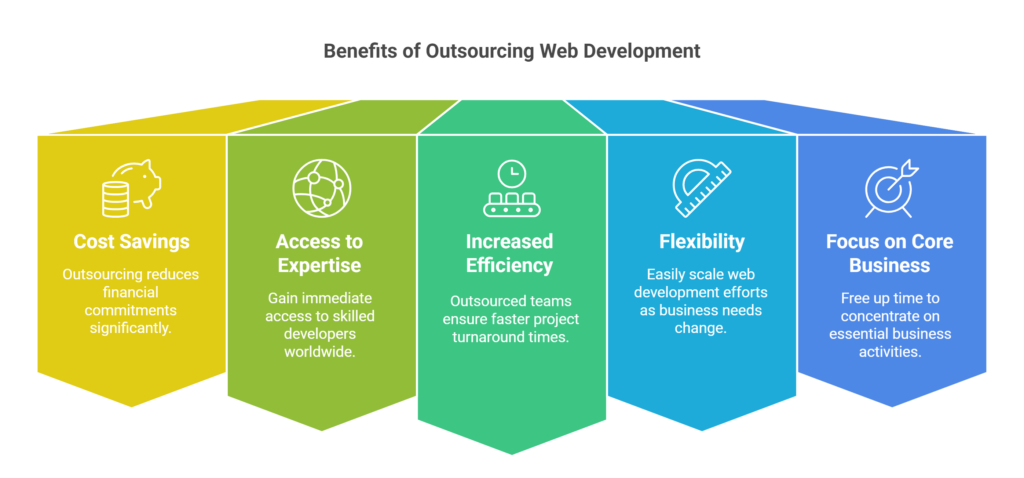
You want your website to look professional, perform flawlessly, and attract customers from day one. But turning that vision into reality isn’t always simple.
Think about this: You’ve got a brilliant business idea, a solid marketing plan, and a clear vision of how your website should look, but there’s one big challenge: you’re not a developer.
Do you hire an in-house team? Try to learn coding yourself? Or spend endless hours managing a project you’re not entirely confident about?
For most businesses, outsourcing web development is the smartest path forward. It helps you access expert talent, move faster, and stay focused on what truly drives growth, your business.
In this guide, you’ll discover the real advantages of outsourcing beyond just cost savings, how to plan your budget wisely, and proven tips for selecting the right web development partner while avoiding common mistakes.
By the end, you’ll know exactly how to get a high-performing website without the stress. Let’s dive in.
What is Web Development Outsourcing?

Web development outsourcing is the process of hiring an external team or agency to build, maintain, or enhance your website instead of handling it in-house.
Rather than assembling a full-time team, you partner with experts who specialize in web technologies and digital solutions. This ensures high-quality results while saving time and costs.
Think of it as bringing in a team of skilled professionals who’ve built countless websites before, so you don’t have to start from scratch.
Whether you need a simple business website, an eCommerce store, or a complex web application, outsourcing gives you access to top-tier developers and software engineers.
And the best part? You get all the expertise without the overhead of hiring, training, and managing an internal development team.
Services Offered by Web Development Outsourcing Providers
Building a website or web application isn’t just about writing code. It’s about creating a fast, user-friendly, and scalable solution that helps businesses grow.
But hiring an in-house team can be costly and time-consuming.
That’s why many companies turn to web development outsourcing providers – experts who handle everything from frontend and backend development to AI-driven automation and cloud solutions.
Here’s a breakdown of the key services they offer.
1. Web App Development
A website isn’t just an online brochure. It’s a powerful tool that can drive engagement, automate tasks, and generate revenue.
Outsourcing providers specialize in building dynamic, interactive web applications tailored to business needs and user requirements.
Whether it’s an online portal, a dashboard, or a customer management system, they develop solutions designed for performance, scalability, and security.
2. Mobile App Development
Mobile traffic dominates the internet. If your website isn’t mobile-friendly or responsive, you’re missing out on a huge audience.
Web development outsourcing teams create responsive web apps and dedicated mobile applications to ensure seamless user experiences across all devices and platforms.
This means faster load times, better navigation, intuitive interfaces, and higher engagement rates.
3. Custom Software Development
Not all businesses can rely on off-the-shelf software. Sometimes, you need custom-built solutions that align with your unique workflows and business goals.
Outsourcing providers develop tailor-made software that improves operational efficiency, automates processes, and enhances productivity.
They use the latest programming languages, frameworks, and development methodologies to build scalable, high-performance applications.
4. Website Design & Development
Your website is often the first impression customers have of your brand. If it’s slow, outdated, or hard to navigate, visitors won’t stick around.
Web development outsourcing providers create visually appealing, high-converting websites that align with your brand identity and business objectives.
They focus on speed optimization, user experience (UX), user interface (UI) design, and mobile responsiveness to ensure maximum engagement and conversions.
5. Front-end Development
A website’s design isn’t just about looks – it’s about functionality, too.
Front-end developers turn static designs into interactive, user-friendly web experiences using HTML, CSS, JavaScript, and modern frameworks like React, Vue, or Angular.
They ensure pages load quickly, buttons respond instantly, animations are smooth, and navigation feels intuitive across all devices and browsers.
6. Back-end Development
The back end is the backbone of any website. It handles server-side logic, manages databases, processes requests, and ensures seamless functionality.
Web development outsourcing teams specialize in building secure, high-performance back-end systems using languages like PHP, Python, Ruby, Node.js, and Java.
A strong back end means faster loading times, better data security, robust server architecture, and smoother overall performance.
7. E-commerce Development
Selling products or services online? You need more than just a basic website.
E-commerce development involves building secure, scalable online stores with seamless payment processing, inventory management, product catalogs, shopping cart functionality, and order tracking.
Outsourcing providers create high-performing e-commerce websites on platforms like Shopify, WooCommerce, Magento, and custom solutions that drive sales and enhance the customer shopping experience.
8. Content Management Systems (CMS)
Updating website content shouldn’t be complicated. A content management system (CMS) allows businesses to create, edit, and manage their website without technical expertise or coding knowledge.
Outsourcing providers develop and customize CMS platforms like WordPress, Drupal, Joomla, and headless CMS solutions, ensuring easy content management, better SEO optimization, and flexible customization.
9. API Development & Integration
Web applications don’t work in isolation. They need to communicate with other platforms and services.
API development and third-party integrations allow businesses to connect payment gateways, CRMs, marketing automation tools, analytics platforms, and other essential services.
Outsourcing providers create custom APIs and implement RESTful services that improve functionality, streamline operations, enable data exchange, and enhance user experience.
10. Database Design & Management
Every website or app needs a secure, well-structured database to store and retrieve data efficiently.
Web development outsourcing providers design, optimize, and manage databases using MySQL, PostgreSQL, MongoDB, and other database management systems to ensure fast performance and robust security.
A well-built database architecture ensures seamless scalability, data integrity, and reliable backup systems as your business grows.
11. Cloud-Based Solutions
Cloud computing has revolutionized web development. Businesses no longer need expensive servers or infrastructure to host their websites or apps.
Outsourcing providers leverage cloud platforms like AWS (Amazon Web Services), Google Cloud Platform, Microsoft Azure, and cloud hosting services to develop and deploy scalable, cost-effective web applications.
Cloud solutions offer flexibility, enhanced security, automatic scalability, and the ability to handle high traffic without downtime or performance issues.
12. AI & Automation Solutions
Artificial Intelligence (AI), machine learning, and automation are revolutionizing web development. Businesses are leveraging AI technologies to optimize user experiences, improve security, and automate repetitive tasks.
Outsourcing providers now integrate AI into development processes to offer:
- AI-powered chatbots and virtual assistants for real-time customer support
- Machine learning algorithms to personalize content, product recommendations, and user journeys
- Automated testing, debugging, and quality assurance to improve software quality
- AI-driven SEO tools and content optimization that analyze and optimize content for better search rankings
- Predictive analytics and data analysis that help businesses make data-driven decisions
By integrating AI and automation technologies, companies can boost efficiency, enhance customer experiences, and gain a competitive edge in their industry.
13. User Testing & Feedback
Even the best-designed websites need rigorous testing. Outsourcing providers conduct user testing, usability testing, A/B testing, and feedback analysis to identify usability issues and improve the overall experience.
By analyzing real user behavior, conducting quality assurance, and gathering user insights, they make data-driven adjustments to enhance functionality, engagement, conversion rates, and overall satisfaction.
Top 5 Benefits of Outsourcing Web Development
Outsourcing web development is becoming more popular, and for good reason. It helps businesses cut costs, speed up projects, and access top-tier talent without the hassle of managing an in-house team.

Instead of spending time and money on hiring, training, and maintaining a development team, companies can focus on what really matters: growing their business and serving their customers.
Here’s why outsourcing web development is a game-changer.
1. Cost Savings
Building an in-house development team is expensive. You have to pay salaries, benefits, office space, equipment, and software licenses. That’s a big financial commitment, especially for small businesses and startups.
Outsourcing removes those overhead costs. You only pay for the work you need, whether it’s a full website build, maintenance, or just a few tweaks and updates. Plus, development agencies already have the right tools, infrastructure, and expertise, so you don’t have to invest in training or new technology.
Another big advantage? Scalability and flexibility. If your project grows, you can quickly bring in more developers. If you need to cut back, you’re not stuck with full-time salaries and long-term commitments. It’s a flexible, budget-friendly way to manage web development projects.
2. Access to Expertise
When you outsource, you’re not limited to local talent. You can work with skilled developers, designers, and specialists from around the world, bringing in fresh ideas, innovative solutions, and expertise you might not find in-house.
Development agencies specialize in web design, coding, software architecture, cybersecurity, and security best practices, so you’re getting experts who are up-to-date with the latest trends, technologies, and industry standards. They know the best frameworks, development tools, programming languages, and security measures to keep your site running smoothly and securely.
Instead of spending weeks (or months) hiring and training a team, you get immediate access to professionals and technical experts who can start working on your project right away.
3. Increased Efficiency
Outsourcing speeds up the entire web development process and project timeline. Experienced developers follow structured workflows, use agile methodologies, implement DevOps practices, and leverage project management tools to keep things on track.
An outsourced team is also focused and dedicated. Unlike an in-house team that might juggle multiple responsibilities, an outsourced team is committed to your project, ensuring faster turnaround times and consistent progress.
And since most outsourcing companies work across different time zones, development can continue around the clock. This means projects move faster, deadlines are easier to meet, and time-to-market is significantly reduced.
4. Flexibility
Business needs change and evolve. Maybe you need a small business website today, but a full eCommerce platform or enterprise solution next year. Outsourcing makes it easy to scale your web development efforts up or down as needed.
With an in-house team, hiring and training take time and resources. But with outsourcing, you can bring in additional developers, specialists, or consultants quickly if your project grows, or scale back when things slow down.
Another perk? Many agencies offer ongoing support, maintenance services, updates, and technical support. That means you don’t have to worry about handling security updates, bug fixes, performance optimization, or new feature additions.
5. Focus on Core Business
Web development is complex and time-consuming. If you’re spending hours managing developers, fixing bugs, troubleshooting issues, or figuring out why a page isn’t loading, you’re not focusing on growing your business.
Outsourcing lets you hand off technical tasks to experts while you focus on marketing, sales, customer engagement, business strategy, and revenue generation.
It also reduces internal distractions and operational burden. Managing an in-house team means dealing with HR, training, workflow issues, and team management. When you outsource, you eliminate those headaches and keep your business running smoothly.
Web Development Outsourcing Models: Which One is Right for You?
Whether you’re a startup seeking a cost-effective solution or an enterprise requiring specialized expertise and scalability, selecting the right outsourcing model is crucial for project success.

Let’s dive into the best web development outsourcing models and engagement approaches and how they can drive your success.
1. Dedicated Team Model
A fully dedicated development team working exclusively on a client’s project with long-term commitment.
Why it works for your company:
- Long-term partnerships result in consistent revenue and business growth
- Your team is fully aligned with the client’s business goals and objectives
- Scalable and flexible, adjusting as the project evolves and requirements change
- Better collaboration, team cohesion, and project continuity
Best for: Businesses with ongoing, complex projects that require long-term development, full control over a dedicated team, and continuous iteration.
2. Staff Augmentation
Expanding a client’s in-house team with your remote developers, specialists, or contractors, working under their management and direction.
Why it works for your company:
- Helps businesses scale their team instantly without full-time hiring or recruitment
- Provides specialized expertise, technical skills, and niche knowledge that their in-house developers may lack
- Clients retain full control over development, project management, and workflow while leveraging your talent pool
- Flexible resource allocation based on project needs
Best for: Companies with an existing in-house dev team that need extra developers, specific skill sets, or additional resources on-demand without the hassle of recruitment.
3. Project-Based Outsourcing
Clients hire your web development company to handle a specific project with a fixed scope, defined budget, clear deliverables, and deadline.
Why it works for your company:
- Allows you to manage the entire project lifecycle from start to finish
- Works well for one-time projects like website development, redesigns, mobile apps, or specific features
- Ensures faster delivery since the project has clear timelines, milestones, and well-defined requirements
- Reduced client involvement in day-to-day management
Best for: Businesses that want a fully developed solution, turnkey projects, or specific deliverables without managing developers or technical details.
4. Nearshore Outsourcing
Offering development services to businesses in nearby countries, neighboring regions, or similar time zones with minimal time zone differences.
Why it works for your company:
- Attracts clients looking for cost-effective yet highly collaborative solutions with real-time communication
- Easier communication, cultural alignment, and overlapping work hours compared to offshore outsourcing
- Helps you expand your market reach, geographic presence, and client base beyond your local region
- Better travel accessibility for on-site meetings if needed
Best for: Businesses that want to outsource development without time zone hassles, communication barriers, or significant cultural differences.
How to Outsource Web Development for Your Business?
Outsourcing web development can be a game-changer for your business. Done right, it saves you time, money, and a whole lot of stress. But if you choose the wrong team or vendor? You could end up with missed deadlines, poor-quality work, and a website that doesn’t function the way you need it to.

So, how do you make outsourcing work for you? Follow these steps to ensure a smooth, successful experience and positive outcomes.
1. Get Clear on Your Project Requirements
Before you start searching for developers or agencies, you need to be crystal clear on what you want. Ask yourself:
- What’s the purpose of my website and what are my primary goals?
- Who is my target audience and user base?
- What features, functionalities, and technical requirements do I need?
- What’s my budget, timeline, and project constraints?
The more detailed you are with your project scope and specifications, the easier it will be to find the right team and avoid costly misunderstandings, scope creep, or revisions later.
2. Find the Right Outsourcing Partners
Not all web developers are created equal. You need to find professionals, agencies, or vendors who can deliver what you need. Here’s how:
- Look online: Platforms like Upwork, Toptal, Clutch, and Freelancer are great for finding experienced developers with real client reviews, ratings, and verified portfolios
- Ask for referrals: Reach out to your network, business contacts, and industry connections. Someone you know may have already worked with a great developer or reliable agency
- Consider different locations: Outsourcing to different countries, regions, or offshore locations can save you money, but make sure you factor in time zones, language barriers, and communication styles
3. Evaluate Your Shortlist Like a Pro
Once you have a list of potential developers or outsourcing companies, it’s time to vet them carefully and conduct due diligence. Look at:
- Their portfolio: Do they have experience in your industry or niche? Have they built similar websites, projects, or applications before?
- Client testimonials and reviews: Are past clients happy with their work, communication, and delivery?
- Communication skills: Can they explain things clearly and professionally? Are they responsive and proactive?
- Technical expertise: Do they have the right skills, certifications, and technology stack?
Pro tip: Don’t just rely on emails or messages. Hop on a quick video call or schedule a consultation to assess their professionalism, communication skills, and cultural fit.
4. Choose the Right Partner
Now it’s decision time! When picking your developer or development partner, consider:
- Their expertise: Do they have the technical skills, domain knowledge, and proven experience to build what you need?
- Availability: Can they meet your timeline, project schedule, and deadlines?
- Cultural fit: Will they align with your company’s work style, values, and expectations?
- Pricing structure: Is their pricing model transparent and aligned with your budget?
Cheap isn’t always better. Sometimes, paying a bit more upfront saves you a ton of headaches, technical debt, and costly fixes down the line.
5. Define the Scope and Budget Clearly
To avoid misunderstandings, scope changes, or budget overruns, clearly outline:
- Project timeline with milestones and key deliverables
- Deliverables and specifications (what exactly will be done and delivered?)
- Payment terms and structure (fixed price, hourly rate, or milestone-based payments?)
- Intellectual property rights and ownership
- Confidentiality and data security measures
Get everything in writing with a detailed contract or service agreement! A well-drafted contract protects both you and your outsourcing partner and sets clear expectations.
6. Manage the Project Like a Boss
Your job isn’t over after hiring a developer or signing a contract. To keep things on track and ensure quality:
- Set up regular check-ins and status updates (weekly or bi-weekly updates and sprint reviews)
- Use project management tools like Trello, Asana, Jira, or Slack for collaboration and transparency
- Provide clear and timely feedback, constructive criticism, and quick approvals
- Monitor progress, track deliverables, and address issues early
Good communication and active project management can make or break an outsourced project. Stay involved, engaged, and collaborative!
7. Review, Test, and Optimize
Once the project is done or reaches completion, don’t just accept it and move on. Carefully review and conduct quality assurance:
- Design and functionality: Does it match what you envisioned and meet requirements?
- Performance: Is the site fast, responsive, and optimized?
- User experience: Is it easy to navigate, intuitive, and user-friendly?
- Cross-browser compatibility: Does it work across different browsers and devices?
- Security testing: Are there vulnerabilities or security risks?
If something’s off or doesn’t meet expectations, address it before finalizing payment and project closure.
Cost matters, but it’s not everything.
The key to successful outsourcing isn’t just finding the cheapest option. It’s finding a reliable, skilled partner who understands your vision, business objectives, and long-term goals.
A great development team will align with your goals, communicate effectively, deliver high-quality results, and provide ongoing support.
Take the time to choose wisely.
A little extra effort in the selection process can mean the difference between a frustrating experience and a top-notch website that helps your business grow and succeed.
How Much Does It Cost To Outsource Web Development?
The cost of outsourcing web development isn’t a one-size-fits-all number or fixed price.
It depends on several factors, including:
- Project complexity: A simple website costs far less than a custom web application or enterprise solution
- Scope of work: The number of pages, features, integrations, and custom functionality all impact pricing
- Outsourcing location: Developers in North America charge more than those in Eastern Europe, Asia, or Latin America
- Level of expertise: Hiring a top-tier agency or senior developers costs more than working with freelancers or junior developers
- Technology stack: The choice of programming languages, frameworks, and platforms affects development costs
- Project duration: Short-term projects vs. long-term engagements have different pricing structures
So, how much should you expect to pay?
Here’s a breakdown of average cost ranges for different types of web development projects:
- Basic Website: A simple website with a few pages, basic functionality, and minimal customization can cost between $1,000 and $5,000.
- E-commerce Website: Developing an e-commerce website with features like shopping carts, payment gateway integration, inventory management systems, and product catalogs typically ranges from $5,000 to $20,000, depending on the complexity and platform choice.
- Custom Web Application: Building a custom web application with advanced functionality, database integration, user authentication, and complex business logic can cost between $10,000 and $50,000, or even higher for enterprise-level projects.
- Mobile App Development: Developing a mobile app alongside a website or as a standalone solution can add to the cost. The price varies based on the platform (iOS, Android, or both), features, complexity, and integrations. On average, mobile app development can range from $20,000 to $100,000 or more.
These figures are just estimates and industry benchmarks. The actual cost of your project can vary significantly based on your specific requirements, business needs, and customization level.
Factors like custom features, third-party integrations, design complexity, and ongoing maintenance all play a role in the final price and total cost of ownership.
Location also makes a big difference in pricing and hourly rates.
For example, outsourcing to Eastern Europe or Asia is often more cost-effective than hiring developers in North America or Western Europe, while still maintaining quality and expertise.
Want a clearer idea of what different projects cost?
Check out this breakdown:
| Web Development Project | Approximate Cost Range |
|---|---|
| Basic Website | $1,000 – $5,000 |
| E-commerce Website | $5,000 – $20,000 |
| Custom Web Application | $10,000 – $50,000 (or more) |
| Mobile App Development | $20,000 – $100,000 (or more) |
Again, these figures are just a guideline and starting point. Your actual costs will depend on project complexity, specific features, technical requirements, and other factors.
That’s why it’s always a good idea to consult with outsourcing providers, request detailed quotes, and get cost estimates before making a decision.
A good provider will assess your needs, break down the costs, provide transparent pricing, and give you an accurate estimate so there are no surprises or hidden fees down the road.
Web Development Outsourcing: When and Why It Makes Sense for Your Business
Let’s be real: building a website isn’t just about slapping some code together and calling it a day. A well-developed website is the backbone of your online presence, digital strategy, and customer engagement, and getting it right takes time, skill, technical expertise, and resources.
But here’s the thing: Not every business has an in-house team of developers, designers, or technical staff ready to go. That’s where web development outsourcing comes in. It allows you to bring in experts who can design, build, optimize, and maintain your site without the overhead of hiring a full-time team.
So, how do you know if outsourcing is the right move for your business? Let’s break it down.
When Should You Outsource Web Development?
Outsourcing isn’t for everyone, but in the right situations, it can be a game-changer and strategic advantage. Here are some key signs it might be time to bring in outside help:
1. You Lack In-House Expertise
If your team doesn’t have the technical know-how, specialized skills, or development experience to build a high-quality website, outsourcing is a no-brainer. Professional web developers bring years of experience, industry knowledge, and best practices, ensuring your site is not only functional but also optimized for performance, user experience, search engine optimization (SEO), and security.
2. Your Budget Is Tight
Hiring an in-house development team can be expensive: salaries, benefits, office space, equipment, and software licenses all add up. That’s a big financial commitment, especially if you’re a startup, small business, or operating with limited resources.
Outsourcing allows you to pay only for the work you need, control costs, and access affordable services, which can significantly reduce expenses, especially if you’re a startup or small business with budget constraints.
3. You’re Working Against a Tight Deadline
Need your website live yesterday? External developers can speed up the process, accelerate development, and deliver faster by working around the clock, especially if you hire a team from different time zones. This means faster turnaround times, quicker project completion, and no need to overwork your internal staff or compromise quality.
4. You Need Scalability
Maybe your website needs are small today, but what about six months from now or as your business grows? Outsourcing lets you scale your development efforts up or down as needed, adjust resources flexibly, and adapt to changing requirements, without the hassle of hiring or laying off employees or long-term commitments.
Why Outsource Web Development?
Outsourcing isn’t just about filling gaps or reducing costs. It’s about unlocking advantages, gaining competitive benefits, and leveraging global talent that can help your business grow. Here’s why companies of all sizes turn to outsourcing:
1. Access to Top Talent
When you outsource, you’re not limited to hiring within your city or country or your local talent pool. You get access to a global pool of developers, international expertise, specialized skills, and diverse perspectives, including specialists in niche areas like AI, machine learning, eCommerce, blockchain, or cybersecurity.
2. Cost Savings
It’s simple math and basic economics: Hiring a full-time team means paying salaries, benefits, office space, overhead costs, and more. Outsourcing allows you to work with experienced developers at a fraction of the cost, reduce operational expenses, and maximize ROI without sacrificing quality or compromising results.
3. Focus on What You Do Best
Your time is valuable and should be spent strategically. Instead of trying to figure out the latest web development trends, technologies, or coding languages, you can focus on growing your business, serving customers, and driving revenue while the experts handle the technical side and complex implementation.
4. Increased Efficiency
Professional developers have streamlined processes, proven methodologies, and optimized workflows in place. That means your project moves faster, progresses smoothly, and more efficiently compared to an in-house team starting from scratch or learning on the job.
5. Faster Time-to-Market
Need your website live ASAP or want to launch quickly? Outsourced teams work quickly, deliver efficiently, and meet tight deadlines, often delivering projects weeks or even months ahead of what an in-house team could achieve. This speed can give you a competitive edge, market advantage, and faster ROI, especially if you’re launching a new product, service, or entering a new market.













